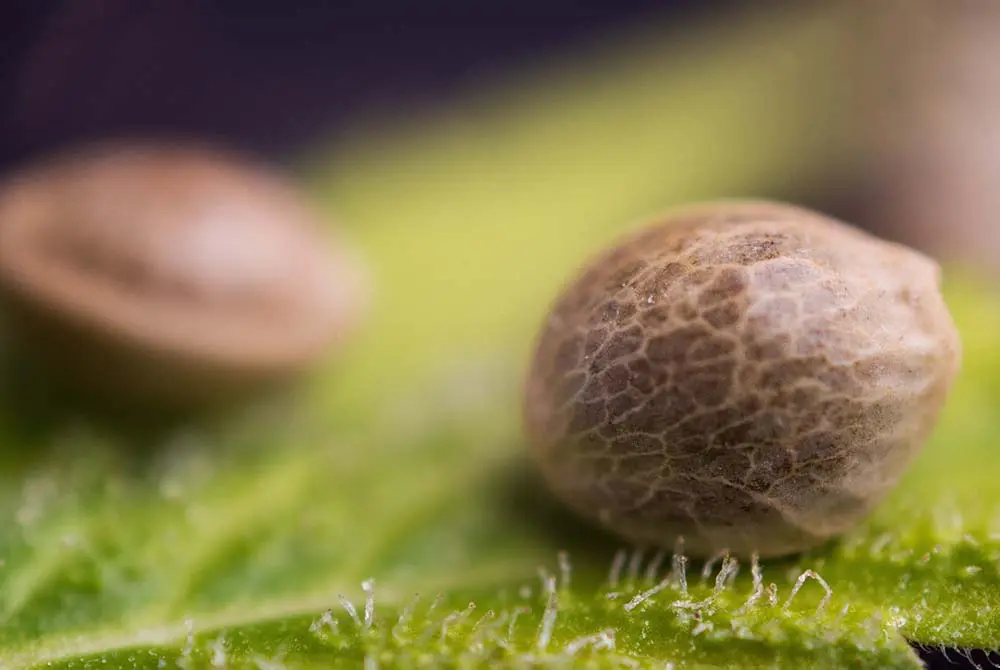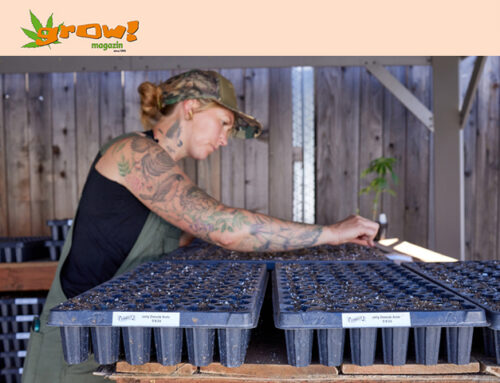Cultivation Breakthroughs for a More Uniform Cannabis Plant

Cultivation Breakthroughs for a More Uniform Cannabis Plant Are Coming’
Better seed genetics, power-free tunable lighting, and other new scientific discoveries are making headway in what has become an ag-tech leading industry.
There is so much going on in the world of cannabis cultivation today, much of it propelling a deeper look into how to control the plant throughout its grow cycle, and work with genetics to reliably produce the same plant with the same effects grow after grow. Methods of achieving standardization and uniformity are driving new discoveries.
This “Tech Innovations” column will examine new ideas in cultivation including managing mold and mildew issues through genetics; keeping the grow facility safe from pathogens; new lighting ideas that do not use electricity; and a better understanding of editing the gene of the cannabis seed.
Generally, cannabis plants are grown from clones—from cuttings of female plants—which will produce a uniform product. But there are problems with that. “Some of the really negative things about growing from clones is the transmission of pests and pathogens,” Nathaniel Pennington said.
Pennington is the founder and CEO of Humboldt Seed Company. He is a former legacy cannabis producer, now a scientist and breeder. “That transmission is probably the worst thing about clone propagation. You can get away without using pesticides and cultivate really nice cannabis if you start clean with seed.”
Seed is basically nature’s tissue culture, he explained, and that is the cleanest and most sterile way to share living plant tissue. “The seed itself is this new life that doesn’t carry with it, 99% of the time, a virus or some other pathogen that might come from a mother plant where you get clones,” Pennington said.
Humboldt Seed Company has developed a way of getting feminized cannabis seed, working with a University of California-Davis genomics and breeding consultant team to develop a proprietary method of breeding feminized seeds (1). The company is doing full sequencing on a number of different cannabis varieties. “And right now, we are doing marker assisted breeding with auto flowers,” Pennington said. “It’s helpful to be able to quickly determine whether a plant inherited a certain trait or not before having to grow it full term to flower. So marker assisted breeding, genome annotation are all the important pieces to our puzzle right now.”
Humboldt and other seed companies are getting an assist with more discoveries on the horizon, such as the results coming from ongoing projects at the Agricultural Genomics Foundation (2), working in collaboration with the Cannabis Genomic Research Initiative (CGRI) to map the cannabis genome and the genetic details of the plant.
One of the CGRI projects (3) is an ultra-high density genetic map of cannabis. “The full genome sequencing is becoming more and more accessible to even companies like ours that are not highly capitalized,” said Pennington.
Editing the Cannabis Seed Gene
What is reportedly (4) the first time a commercial company has performed genome editing on a cannabis plant was announced by Israeli startup CanBreed, working in a 12,000 square foot facility for seeds testing, and a 45,000 square foot farm for trialing and seed production (5).
The seed gene editing was done using CRISPR-Cas9 gene editing technology (6), designed to make the plant resistant to mildew. CRISPR/Cas9 edits genes by precisely cutting DNA and then letting natural DNA repair processes take over.
The company aims to create and then sell cannabis seeds (called the F1 hybrid [7]) that have a powdery mildew resistance trait, and hopefully use the same technology to edit additional genes to enhance other traits in the plant.
Ido Margalit is an agronomist, the former CEO of medical devices startup Syngenta, and the co-founder of CanBreed. “What you have in the cannabis industry is a lack of standardization and uniformity,” he said. “The cannabis plant is grown from a clone. The genetics have not been stabilized. If you do not stabilize the genetics of a plant, you cannot reproduce it from seed. Because that means that each and every seed from a plant is genetically different. In order to get a stable plant, a stable uniform seed, there is a process that takes 3 to 4 years. And nobody has applied that knowhow, that is very common in the seed industry, to the cannabis seed,” he said.
Tomatoes and other crops have developed resistance to the same sort of mildew that is affecting cannabis, he said. “What we have done is we looked at the genes that these mildew resistance plants have and asked if cannabis has the same gene. The answer is yes. Cannabis is just another agriculture crop. No different from most of the other crops. A plant is a plant.”
Helping the Hemp Industry
CanBreed also has a subsidiary US company that operates a 140,000 square foot hemp seeds production farm.
Their gene editing work in cannabis includes the hemp seed in a process to help hemp farmers keep a legal level of tetrahydrocannabinol (THC) in their hemp plants. THC levels can become “hot” as a result of bad genetics, according to one study (8). “We have identified and edited out the gene that controls the amount of THC,” Margalit said. “And we are going to bring that to the US by the end of 2022. It’s the first stable uniform hemp seed that has zero genetic ability to express THC.”
Margalit also makes a distinction between the gene seed editing he does and genetically modified organisms (GMO). Although GMOs are in a lot of the foods humans eat, most of the GMO crops grown in the United States are used for animal food. But there are other uses. For example, genetic engineering, which is the process used to create GMOs, was first used to make human insulin, a medicine used to treat diabetes (9).
“GMO is the expression of a foreign gene,” Margalit said. “We do not introduce any foreign material into the plant in seed gene editing. We alter a certain gene that is in the plant. We know that if you take out that gene, the gene stops to function as it should. Once you alter the function, you get the resistance (to mildew).”
Can gene editing catch on as a means of getting an identical cannabis plant every time? Pennington has his take on that: “It takes so much to alter the specific cultivar or strain to inherit, time after time after time, this powdery mildew resistance,” he said. “The market is so fickle right now that I’m not sure that something being resistant to powdery mildew is the number one selling point for cannabis.”
David Kessler, the chief science officer at Agrify, a cannabis grow solution provider, said that there are “dozens and dozens of people trying to do this”—stabilize the seed gene—because it’s “a very big deal.”
“When I go to Home Depot and I buy a pack of tomato seeds, 99 out of 100 of those tomatoes are going to grow the same size at the same rate, and produce a pretty homogenized tomato. It’s going to be what we call stabilized. Where we are with cannabis is the seed is all over the place. It’s representative of a very diverse genome. So if I grow 10 seeds, I’m very likely to have 10 different phenotypic and chemotypic expressions, even though technically they came from the same mother.”
More Tools
More tools and devices are being brought to bear in the indoor cannabis grow operations as other sources of new technology are being investigated. One such device is the Blue Zone, from Agrify. It’s a military style device to reduce odors and kill mold and bacteria.
Blue Zone works by circulating air through a reaction chamber designed to destroy pathogens. Chemical compounds that create odors are oxidized, while mildew spores and botrytis (a common outdoor fungus) are drawn through a self-contained ultraviolet light which kills them instantly (10). “The technology itself was developed in early 2000s for the US military, and it is currently installed on all US aircraft carriers,” Kessler said. “What’s interesting, though, is the original application wasn’t for human biosecurity or safety. It was because the product was able to destroy ethylene, which is a gas created through the maturation and ripening of produce. So using this, they were able to extend the shelf life of fruits and vegetables for soldiers quite a bit.”
Cultivators are looking more closely at the biosecurity of their cultivation, Kessler said. “Cannabis is one of the highest value agricultural commodity crops on a per weight basis,” he said. “So of course, you want to do everything in your power to prevent problems or address them if you have them.”
Each individual Blue Zone is plug and play, he said, meaning that a cultivator operator can literally put it on a table, plug it in, switch it on, and it will control 15,000 cubic feet of airspace for pathogens. “It’s also going to make the air cleaner and healthier for your employees. And I think that that’s not to be undervalued,” Kessler said. “I think that if you can take care of your team, they’ll take good care of your facility, and then everyone’s winning together.”
Nanotechnology and Cannabis
Another new technology being brought to bear in cannabis cultivation is the quantum dot, which is a nanometer-sized semiconductor particle. Quantum dots are widely used for their unique optical properties, as they emit light of specific wavelengths if energy is applied to them.
These wavelengths of light can be accurately tuned by changing various properties of the particle, including shape, material composition, and size (11).
UbiQD, an advanced materials company, created their UbiGro product that uses luminescent films containing their quantum dot nanotechnology to essentially tweak sunlight without using electricity. Using UbiGro, sunlight can be manipulated to enhance photosynthetic efficiency and boost fruit and flower production. Quantum dots in UbiGro shift a portion of ultra violet and blue light towards the red because increased red light improves chlorophyll absorption.
“We describe it as a layer of light that helps plants get more from the sun,” said Hunter McDaniel, founder and CEO of UbiQD (12). “It’s based on the idea that has really been maturing over the years around the quality of light impacting crop health and productivity, which is equally important as the quantity of light. Growers have largely focused on quantity, especially in the cannabis industry.”
Outside of photosynthetically active radiation (PAR) (13), photons are generally thought to be useless for photosynthesis, he explained. “That was the old way of thinking. And then within power, 400 to 700 nanometers, light is actually PAR. But not all photons are kind of equal for photosynthesis,” he said.
Dr. Keith McCree, a researcher at Texas A&M, pioneered work on lighting in 1970 with the McCree curve (14), which has been used to provide a means of establishing the optimal wavelength selections and spectral ratios for different crops. It’s a plot of 22 grain, oilseed and vegetable crops (including cantaloupe, clover, cotton, lettuce, tomato, squash, cucumber, and soybean) where he examined photosynthetic efficiency versus color.
The aim of the measurements was to “provide a factual basis for a standard definition of photosynthetically active radiation.”
Red light is about 30%, or maybe even 50% more efficient than green light, and about 20–30% more efficient than blue light, just on a photon to photon comparison, McDaniel stated. “So if only you could just give plants more red light, they should be more productive,” he added.
In addition to changing the color, UbiGro also gives more diffuse light to the plant. “So by diffusing light, you can get more light to the lower canopy, more full plant light,” said McDaniel.
Plants have evolved to sense the season partially by color because the sun sits lower in the sky as the season goes on. “You get more red in the spectrum. So this is well known in the cannabis community that more red light can help trigger flowering,” McDaniel said. “But in the earlier stage of growth, if you give plants more blue light, it triggers them into thinking ‘Hey, it’s summertime. I need to grow big and tall.’ Then with red light it thinks ‘I should start to worry about winter. Winter’s coming. I need to start reproducing myself.’ The fruit and the buds are all about the plant’s way of surviving the winter,” McDaniel said.
With UbiGro, a grower effectively tricks the plant into thinking that it’s time to do whatever the grower wants it to do. “We tend to focus more on the productivity of the plant, which means flower, fruit, buds, and that can be triggered by more red light.”
“Cannabis is a complicated crop to grow well,” McDaniel said. “The industry is a difficult one to approach because there’s so much regulatory uncertainty and variation between the states, and sort of a boom and bust cycle. It’s a very capital intensive plant, labor intensive, energy intensive. So the profitability isn’t as great as you might expect. You see that it’s 1000 times more valuable per pound than tomatoes, so it should be 1000 times more lucrative right? Well, now it actually costs a lot more to produce it too.”
McDaniel thinks that cannabis can be a beachhead market—a first market—for new technology. He explained that the cannabis industry is also very open to technology. “I think it’s just kind of in their DNA, to be trying new things and be a little bit more of like a maverick,” he said.
“Food and cannabis are meeting in the greenhouse. The cannabis industry is coming out of out of the dark, out of the warehouse, and into the greenhouse. The food industry is moving out of the field into the greenhouse,” McDaniel added. “And then they’re becoming kind of collaborative in the greenhouse, so the greenhouse industry is exploding right now because you’ve got it coming from both sides. We play into that.”
Conclusion
The ongoing problem with cannabis that seed geneticists have to understand is that it has been cultivated by humans for thousands of years. It’s hard to decipher the origins of the plant and the true genetics of the seed. “Fortunately there are still wild populations of cannabis that are self-replicating or self-seeding every year,” said Pennington.
He went on a pilgrimage to Jamaica to find the varietals grown there, such as strains like Lamb’s Bread (also known as Lamb’s Breath with an original inbred line dating back to King Solomon [15]). “Unfortunately what we found was that they were almost gone from the whole island. We would go to these common places where cannabis is cultivated and ask if they had any of those seeds for those old Jamaican strains. And they would say ‘I don’t know about that. But OG Kush seeds, we got them. We got Sour Diesel seeds,’” said Pennington.
He said that he is looking for someone out there who would like to apply to work on a grant proposal in California with Humboldt Seed Company to start a nonprofit and help them start a cryogenic cannabis seed storage facility. “What we are after is a way to predict—with say, 10,000 seeds—exactly what they’re going to look like, smell like, and how big they’re going to get when they flower,” Pennington said.
Kessler said that, first and foremost, companies working on the leading technology for the industry have to appreciate that cannabis is 100 years behind every other modern agronomic crop. “It has not been legal, therefore universities didn’t work with it. The information that was held by legacy cultivators was really closely guarded and non-scientific. And at the same time, it comes from a group of people where there is data collection evidence. And so therefore, there was a lot of non-institutionalized knowledge,” he said. “It was spread out, it was circumstantial, it was not following the scientific process. Now, that does not devalue the information, it does not make it wrong. It just makes it not sustainable or substantiable.”
According to McDaniel, one lesson he has learned about the industry is how much variety there is. “It’s a big industry. So you know, you’d expect there to be some variety. But just walking into one greenhouse after another, there are so many different growing techniques and structures and different kinds of materials, different types of roofing. No two greenhouses are the same. But it also means that we really have to be collaborative with the grower, get down there, get our hands dirty, and be with them in the ground, if you will, in the greenhouse. Then spend a lot of time with them, which is great.”
References
- https://humboldtseedcompany.com/feminized-seed-information/.
- https://agriculturalgenomics.org.
- https://agriculturalgenomics.org/research/.
- https://www.timesofisrael.com/israeli-startup-says-it-has-edited-cannabis-plant-gene-for-fungus-resistance/.
- http://www.can-breed.com/page3.html#content4-c.
- http://www.crisprtx.com/gene-editing/crispr-cas9.
- http://www.can-breed.com/page4.html.
- https://onlinelibrary.wiley.com/doi/10.1111/gcbb.12667.
- https://www.fda.gov/food/agricultural-biotechnology/gmo-crops-animal-food-and-beyond.
- https://www.agrify.com/bluezone-cannabis-air-scrubber.
- https://avantama.com/what-is-a-quantum-dot/.
- https://ubiqd.com/vision/.
- https://www.sciencedirect.com/topics/agricultural-and-biological-sciences/photosynthetically-active-radiation.
- https://www.vegenaut.com/pl/.wp-content/uploads/sites/2/2017/07/PPFD_essential_article.pdf.
- https://oldschoolba.com/product/lambsbread/.

ABOUT THE COLUMNIST
DAVID HODES has written for many cannabis publications, and organized or moderated sessions at national and international cannabis trade shows. He was voted the 2018 Journalist of the Year by Americans for Safe Access, the world’s largest medical cannabis advocacy organization.
How to Cite this Article
D. Hodes, Cannabis Science and Technology 4(8), 14-18 (2021).






